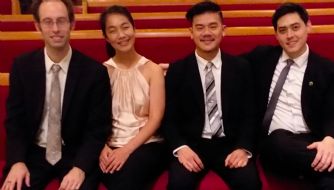|
Symphony
FROM THE NEW WORLD TO THE OLD WORLD
by Peter Lert
Saturday, June 14, 2025
Chamber
MC2 DUO RECITAL CLOSES 222'S SEASON
by Terry McNeill
Saturday, June 14, 2025
Choral and Vocal
CANTIAMO SONOMA'S LUSCIOUS A CAPELLA SINGING IN SEASON ENDING CONCERT
by Pamela Hicks Gailey
Sunday, June 8, 2025
Symphony
SRS SEASON ENDS WITH RESOUNDING TA-TA-TA-BANG
by Terry McNeill
Sunday, June 1, 2025
Symphony
YOUTHFUL VIRTUOSITY ON DISPLAY AT USO'S MAY CONCERTS
by Peter Lert
Saturday, May 17, 2025
Symphony
MYSTICAL PLANETS AND LIVELY GERSHWIN ORTIZ AT FINAL SRS CONCERT
by Peter Lert
Sunday, May 4, 2025
Symphony
VSO'S CONCERT MUSIC OF TIME, MUSIC OF PLACE
by Peter Lert
Sunday, April 27, 2025
VOCAL ELEGANCE AND FIRE AT THE 222'S RECITAL APRIL 26
by Pamela Hicks Gailey
Saturday, April 26, 2025
CANTIAMO SONOMA SINGS AN INSPIRED GOOD FRIDAY MOZART REQUIEM CONCERT
by Pamela Hicks Gailey
Friday, April 18, 2025
DRAMATIC SHOSTAKOVICH SYMPHONY CLOSES PHILHARMONIC'S 25TH SEASON
by Terry McNeill
Sunday, April 13, 2025
|
 |
 Telegraph Quartet in Mill Valley Nov. 10 (A. Wasserman Photo) |
SPIRITUAL LATE BEETHOVEN QUARTET HIGHLIGHTS MILL VALLEY CHAMBER CONCERT
by Abby Wasserman
Sunday, November 10, 2019
Beethoven’s String Quartet No. 14 in C-sharp minor, Op. 131, called “unparalleled in its inexhaustibility” by critic Thomas May, is a daunting challenge. Orchestral in concept, filled with wit and charm, melancholy and fury, it almost overwhelms listeners. Playing the frenetic Scherzo, a violinist once commented, was “like galloping through hell.” But the piece is sublime, and the Telegraph Quartet, performing it Nov. 10 at Mt. Tamalpais Methodist Church for the Mill Valley Chamber Music Society, fully met its challenges.
The San Francisco-based group: Eric Chin and Joseph Maile, violins; Pei-Ling Lin, viola; and cellist Jeremiah Shaw, delivered a performance of great eloquence, and did so after preceding the Beethoven with two other grand works: Berg’s Quartet No. 3 and Bartók’s Fourth Quartet. The concert was a tour-de-force.
Comments and brief musical illustrations by Messrs. Maile and Chin prefaced each selection. Mr. Maile described Berg’s two-movement piece from 1910 as “packed full of character emotions and overwrought feelings.” In it, Berg, self-taught before composer Arnold Schoenberg became his mentor and teacher, straddles Schoenberg’s twelve-tone technique and the Romantic tradition of their Viennese forbears Brahms and Mahler. Schoenberg wrote of the piece, Berg’s first mature work, that it “surprised me in the most unbelievable way by the fullness and unconstraint of its musical language, the strength and sureness of its presentation, its careful working and significant originality.”
Its first movement, Langsam, is a moody soundscape of sighing rises and sonic falls and agitated trills. Bowing effects conjured up different characters for a four-way dialogue; and even when they harmonize, there’s a broad edge of dissonance. The second movement, Mässiger viertel (“moderate quarter”), further engages the players in a conversation that is punctuated by string tremolos, ponticelli, pizzicati and glissandos. Momentum flags and gathers anew, but the piece ends abruptly, as though its musical momentum has hit a sonic wall.
Bartók’s five-movement Quartet, Mr. Chin explained prior to the performance, is structured in an arc: movements one and five and two and four are connected thematically, with an ethereal third movement, Non troppo lento, as the anchor. He also pointed out that Bartók loved bugs, and we would hear them scurrying around in the piece, as well strong rhythms and haunting melodies of Hungarian folk music the composer meticulously researched and championed.
Throughout the quartet one heard slashing rhythms that brought Stravinsky to mind, but not because Bartók was copying; rather, both composers incorporated similar folk music into compositions. Biting notes and offbeat rhythms characterized some of the most exciting moments in the Bartók, which the Telegraph players attacked with virtuosity and also nuance. The third movement was shimmering night music: melodic, plaintive and moonlit. A bird song similar to Vaughan Williams’ “The Lark Ascending” hovered exquisitely toward movement’s end. Bartôk’s music often shows the importance of inserting calm into the sonic fabric of great intensity, and here he employed different effects to make the strings speak changing idioms. The Allegretto pizzicato fourth movement showcased how varied “mere” string plucking can be, from light clicks to vigorous slaps that Bartôk claimed as his own, the string lifted high so that descending, it loudly slaps the instrument’s wood.
Following intermission the audience settled in for a performance of one of Beethoven’s transcendent quartets. Mr. Maile speculated that chronologically, the Beethoven would have come first on the program, because the others “wouldn’t have been possible” without its innovations. The C-Sharp Minor Quartet is 40 minutes long and has seven movements (unprecedented at the time) and each is played without pause. It begins with a slow fugue, creating a fateful atmosphere that while chorale-like, is reminiscent of Bach’s “descending angels” in some fugues of the Well-Tempered Clavier. The Telegraph players’ instruments blended thrillingly, even in unison projecting distinctive, individual voices.
The most powerful of the seven movements was the fourth, (Andante ma non troppo e molto cantabile), a theme and variations where each variation is played in a different style and by different instrumental combinations. The ensemble’s lively, witty Presto (movement five) sounded like an obsessive spinning wheel, and the final Allegro in sonata form incorporated and reorganized the fugue from the first movement. Responding to the music’s vital force, the Telegraph potently conveyed the resignation, anger and defiance Beethoven wrote into the piece.
As the final passionate notes faded, the Mill Valley audience rose to shower the Telegraph Quartet with accolades.
|

